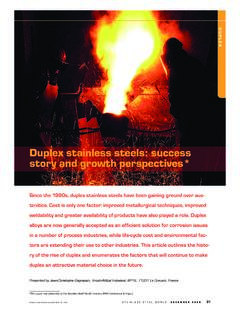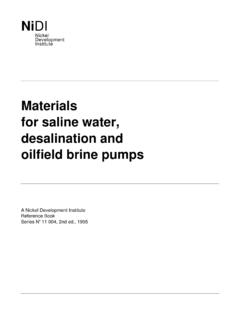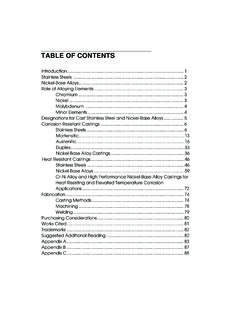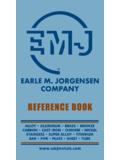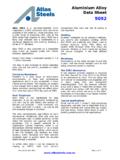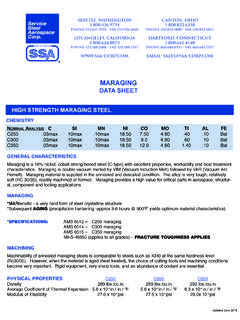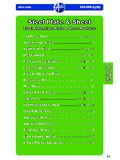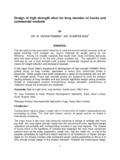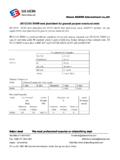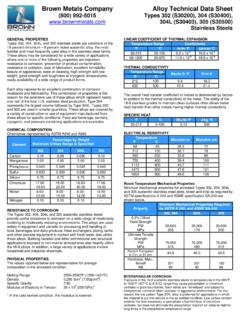Transcription of High- Performance Stainless Steels
1 high - Performance Stainless Steels The material presented in this reference book has been prepared for the general information of the reader and should not be used or relied upon for specific applications without first securing competent advice. Nickel Development Institute, its members, staff, and consultants do not represent or warrant its suitability for any general or specific use and assume no liability or responsibility of any kind in connection with the information herein. Drawings and/or photographs of equipment, machinery, and products are for illustrative purposes only, and their inclusion does not constitute or imply any endorsement of the companies that manufacture or distribute them.
2 This report was prepared by Curtis W. Kovach, Technical Marketing Resources, Inc., Pittsburgh, PA, USA, consultant to the Nickel Development Institute. The Front Cover shows a heat exchanger with SAF 2507 tubes for aggressive chloride service TABLE OF CONTENTS. Introduction .. 3. Classification of Grades ..4. Austenitic High- Performance Stainless Steels ..4. Ferritic High- Performance Stainless Steels ..7. Duplex High- Performance Stainless Steels ..8. Physical Metallurgy .. 9. Phase Relations in the Iron-Chromium-Nickel System .. 9. Secondary Phases .. 13. Kinetics of Phase Precipitation Reactions.
3 15. Austenitic Stainless Steels .. 16. Ferritic Stainless Steels .. 17. Duplex Stainless Steels .. 18. Mechanical Properties .. 20. Austenitic Stainless Steels .. 20. Ferritic Stainless Steels .. 25. Duplex Stainless Steels .. 27. Physical Properties .. 29. Corrosion Resistance .. 35. Resistance to Inorganic Acids .. 35. Resistance to Organic Acids .. 40. Resistance to Alkalies and Alkaline Salts .. 42. Chloride- and Other Halide Ion-Containing Aqueous Environments .. 44. Near Neutral Environments Natural Waters and Brines .. 48. Influence of Microbial Activity .. 53. Oxidizing Halide Environments Chlorinated Cooling Waters and Bleach Solutions.
4 53. Acidic Environments Containing Halides Flue Gas Condensates.. 56. Stress Corrosion Cracking .. 60. Water and Brine Environments .. 62. Sour Oil and Gas Environments .. 64. Hydrogen Environments .. 66. Corrosion Acceptance Tests .. 67. TABLE OF CONTENTS (continued). Fabrication .. 70. Hot Working .. 70. Cold Working .. 71. Annealing .. 72. Machining .. 74. Welding .. 75. Austenitic Stainless steel Grades .. 75. Ferritic Stainless steel Grades .. 79. Duplex Stainless steel Grades .. 79. Surface Condition .. 82. Applications .. 83. Acknowledgements.. 85. Works Cited .. 85. Appendix 1.
5 89. Appendix 2 (A) .. 91. Appendix 2 (B) .. 91. Appendix 2 (C) .. 92. Appendix 3 .. 92. Appendix 4 .. 93. as individual grades, may offer optimum INTRODUCTION. Performance for a specific requirement. The The High- Performance Stainless Steels are a higher nickel austenitic grades are generally family of Stainless Steels which have distinctly preferred for severe acid service and for superior corrosion resistance in a wide variety of resistance to chloride pitting and stress corrosion aggressive environments when compared with the cracking. They are often selected for flue gas standard Stainless steel grades such as Type* cleaning equipment handling acid condensates, 304L, which contains only 18% chromium and or acidic solutions containing strong oxidants 8% nickel (18-8), and Type 316L, which contains such as in paper bleaching.
6 Where field similar chromium and nickel and 2% molybdenum fabrication is an important consideration, the (18-10-2). Their superiority in resisting pitting and austenitic grades are favoured because of their stress corrosion cracking is especially evident in relative ease of welding; grades from this family environments containing the chloride ion. This have been used extensively in offshore and Performance is obtained by using a high level of nuclear piping where weld quality is extremely chromium, nickel, molybdenum, and nitrogen important. If the requirement is for thin sheet, the alloying for corrosion resistance, and by producing ferritic grades will usually be most cost-effective.
7 These grades with very low carbon contents to therefore, they have been used as the tube preserve this resistance while allowing hot material in many kinds of heat exchangers. The fabrication and welding. The commercial origins of duplex grades are often selected where strength the High- Performance Stainless Steels came with is advantageous. They have been used in the advent of steel melting and refining pressure vessels for the chemical process technologies that made it possible to industry, and have seen extensive service in heat economically produce compositions having very exchangers.
8 All three families of the high - low carbon content and close composition Performance Stainless Steels will deliver a wide control. Among these technologies are vacuum range of resistance to chloride pitting and stress melting, electron beam remelting, electroslag corrosion cracking superior to that remelting, and, most notably today from a of Types 304 and 316; so fabrication commercial standpoint, vacuum oxygen considerations often determine the final material decarburization (VOD) and argon-oxygen choice in the case of chloride service. decarburization (AOD). Beginning in the 1970s, these Stainless Steels have grown in number and The High- Performance Stainless Steels are more in technical and commercial importance.
9 This technically demanding than Types 304 and 316. book provides an introduction to these Steels for with regard to metallurgy and fabrication those whose materials needs extend beyond the requirements. This is due to the nature of capabilities of the standard grades, and for those the Steels themselves and the demanding who will benefit from a discussion of the applications in which they are used. A thorough engineering and corrosion Performance properties understanding of these Stainless Steels is of the High- Performance Stainless Steels . necessary to use them successfully. This book provides assistance in making the optimum There are three primary classifications within the material selection for a given application, and High- Performance Stainless Steels .
10 They are the provides guidance in the fabrication and use of austenitic, ferritic, and duplex (austenitic-ferritic) the selected grade. Because of the complexity of families. The Stainless Steels in each family have applications and large number of grades general similarities, but there is also a wide range available, this book can serve only as an of corrosion resistance and other characteristics. introductory guide. The reader is encouraged to This allows a broad spectrum of existing and consult with manufacturers to learn more fully the potential applications where each family, as well advantages, limitations, and specific requirements of individual materials.
